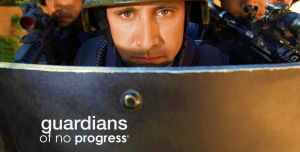Guardians of no progress.
It started out simply. A way for me to “call out” less than stellar behavior that was counter-productive to change while keeping the focus on the behavior and NOT the people. Guardians of no progress©. You know – those rascals that sit in their offices and think through all the reasons why change will not work.
Whether it’s in my keynote speeches, or my leadership role, “guardians of no progress” resonates with everyone leading change. We all know one. And when I share the term, it is always met with a smile and an almost instant list of names that fit the description.
But the focus on the people isn’t the issue. We need to stop. We need to focus on the behavior. When you take time to separate what the behavior looks like “unattached” to names, it lets others see it for what it is. Quite simply, it removes the emotions associated with the people doing the behavior and allows everyone to focus on understanding the behavior for what it is. Fear. And how as a leader, you can and should avoid the pitfalls.
For many organizations, these team members look the same. Guardians of no progress overtly support the change. It’s their version of camouflage. And then later because they want everyone to be safe. They bring questions, spot issues (and non-issues), identify risks that cause others to alter the course or slow the change.
It can also bring a sense of fun to the conversations around change. Yes, fun…
Use the term when you want to call out behavior without attacking the person. Just try it…it keeps everyone focused on supporting the change vs. being called out as the “guardian of no progress.” No one wants to be that guardian.
By taking the time to describe the behavior as a team, it allows everyone to see the signs and stay committed to their role which is to support the change and ensure a successful transition. In other words, change is going to happen, how do we work together to do it well.
Do you know any guardians of no progress?
What does your list look like?
Is it well understood by your you and your team? I’m excited to hear your thoughts and your ideas for shining the spotlights on this important change obstacle.


This Post Has 0 Comments